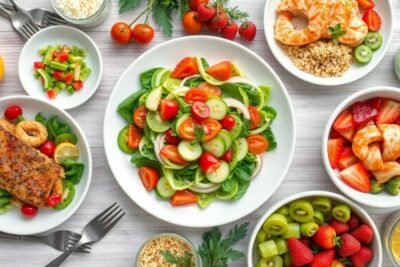
7-Day Meal Plan to Reverse Insulin Resistance
- Understanding Insulin Resistance
- Importance of Diet in Managing Insulin Resistance
- Overview of the 7-Day Meal Plan
- Daily Meal Breakdown: Day 1
- Daily Meal Breakdown: Days 2-7
- Snacks and Beverages to Incorporate
- Tips for Success While Following the Meal Plan
- The Role of Physical Activity
- Monitoring Progress and Making Adjustments
Understanding Insulin Resistance
Insulin resistance is a condition that occurs when the body’s cells become less responsive to the hormone insulin, which regulates blood sugar levels. This insufficient response leads to elevated levels of glucose in the bloodstream, prompting the pancreas to produce more insulin. Over time, this can result in an array of health complications, including type 2 diabetes, heart disease, and obesity. Understanding insulin resistance is crucial, as it is becoming increasingly prevalent in modern society, particularly with the rise of sedentary lifestyles and poor dietary choices.
The development of insulin resistance typically occurs in stages, beginning with the overconsumption of sugars and processed carbohydrates. When these foods are consumed in excess, the body must produce higher levels of insulin to manage the increased blood glucose. With continuous high insulin levels, a phenomenon known as "downregulation" happens—this is when the insulin receptors on cells become less sensitive and require more insulin to achieve the same effect. At this juncture, individuals may not notice any symptoms; however, this state is often a precursor to serious health problems.
Research indicates that lifestyle factors including lack of physical activity, poor diet, and obesity contribute significantly to the prevalence of insulin resistance. Consequently, individuals with this condition face higher risks for metabolic syndrome, which encompasses various health issues like hypertension and dyslipidemia. Additionally, prolonged insulin resistance can lead to long-term complications such as cardiovascular diseases, where the arteries may harden and narrow due to chronic blood sugar elevation.
Recognizing and addressing insulin resistance is vital for preventing its associated health complications. A strategic approach, such as implementing a structured 7-day meal plan to reverse insulin resistance, can be integral in managing this condition. By combining dietary adjustments with lifestyle changes, individuals can positively influence their health outcomes. Understanding the mechanisms and implications of insulin resistance lays the groundwork for effective intervention.
Importance of Diet in Managing Insulin Resistance
Insulin resistance is a condition wherein the body’s cells fail to respond effectively to insulin, leading to elevated blood sugar levels. One of the most significant factors in managing and potentially reversing this condition is diet. A well-structured 7-day meal plan to reverse insulin resistance can greatly enhance one's health and metabolic function. Diet plays a critical role because the types of foods consumed directly affect insulin sensitivity. A balance of macronutrients—proteins, fats, and carbohydrates—is essential in this aspect.
When crafting a meal plan designed to reverse insulin resistance, it is essential to prioritize whole foods over processed options. Whole foods are typically rich in nutrients and provide essential micronutrients that support overall health. Furthermore, foods high in fiber, such as vegetables, legumes, and whole grains, should be emphasized. Fiber not only slows down the absorption of glucose but also contributes to satiety, assisting in weight management—another pivotal factor in improving insulin sensitivity.
The inclusion of healthy fats, such as those found in avocados, nuts, and olive oil, also plays a fundamental role in balancing blood sugar levels. These fats slow the digestion process and mitigate spikes in insulin that can occur with high-carbohydrate meals. Additionally, maintaining a focus on low glycemic index (GI) foods can be beneficial. Low GI foods are digested and absorbed more slowly, preventing rapid fluctuations in blood sugar levels, which helps in the overall management of insulin resistance.
In conclusion, implementing dietary changes that emphasize whole foods, balanced macronutrients, and nutrient-dense options is paramount in reversing insulin resistance. A well-planned 7-day meal plan to reverse insulin resistance can facilitate the development of healthier eating habits that promote long-term success in managing this condition.
Overview of the 7-Day Meal Plan
The 7-day meal plan to reverse insulin resistance is meticulously designed to support individuals in managing their insulin levels and promoting overall health. This structured nutritional guide offers a variety of meals for each day of the week, focusing on nutrient-dense foods that are low in refined sugars and high in fiber. Such a regimen is particularly beneficial for those looking to reduce insulin resistance and improve metabolic health.
Each day of the meal plan has a specific theme that corresponds to a particular dietary focus, such as incorporating lean proteins, healthy fats, or low-glycemic carbohydrates. For instance, one day may emphasize leafy greens and legumes, while another might concentrate on whole grains and nuts. This thoughtful diversity ensures that participants obtain a wide range of essential nutrients, which can aid in stabilizing blood sugar levels and enhancing satiety.
Breakfasts in the meal plan feature satisfying options like oatmeal topped with berries, or smoothies packed with spinach and avocado. Lunches often include robust salads or protein-rich dishes, while dinners provide wholesome entrees such as grilled chicken or baked fish with vegetables. Snacks are included as well, focusing on nutrient-rich choices like almonds or Greek yogurt to curb cravings between meals. The rationale behind these combinations lies in their ability to promote steady energy levels, which is crucial in the management of insulin resistance.
Consistency in following this 7-day meal plan plays a pivotal role in achieving results. Participants are encouraged to adopt these eating habits beyond the initial week, fostering lasting changes in their lifestyle. By adhering to the outlined meal plan and themes, individuals can expect improvements in their insulin sensitivity and overall health, paving the way for a more balanced and thriving life.
Daily Meal Breakdown: Day 1
On Day 1 of the 7-day meal plan to reverse insulin resistance, the focus is on meals that are both nutritious and designed to enhance insulin sensitivity. Each meal includes a combination of healthy fats, lean proteins, and low-glycemic carbohydrates to maintain stable blood sugar levels.
For breakfast, consider a spinach and mushroom omelet made with two eggs, sautéed in olive oil. This dish provides a rich source of protein while the spinach and mushrooms add essential fiber and nutrients. You can serve it with a side of a small portion of berries, such as blueberries, which are low in sugar and packed with antioxidants. For those following a plant-based diet, a tofu scramble with similar vegetables is an excellent alternative.
Lunch includes a quinoa salad mixed with chickpeas, cherry tomatoes, cucumber, and a light lemon-tahini dressing. Quinoa is a complete protein, while chickpeas contribute to increased fiber intake. This combination not only promotes satiety but also supports blood sugar control. Vegetarians can opt for brown rice or farro as a substitute for quinoa without losing nutritional value.
Dinner features grilled chicken breast served with steamed broccoli and a small sweet potato. Chicken is a great source of lean protein, and broccoli is rich in vitamins and minerals that support metabolic health. Sweet potatoes provide complex carbohydrates that release energy slowly, helping to manage insulin levels. For a vegan option, grilled tempeh can replace the chicken, and pairing it with roasted cauliflower instead of sweet potatoes will maintain the meal's nutritional integrity.
For snacks, consider almonds or a serving of Greek yogurt with a sprinkle of cinnamon. These foods are low in sugar yet rich in protein and healthy fats, making them ideal for keeping hunger at bay throughout the day. Alternatively, vegetable sticks with hummus can serve as a satisfying option for those seeking more plant-based inspirations.
Following this structured meal plan on Day 1 sets a positive tone for the remaining days, guiding individuals towards reversing insulin resistance while enjoying a variety of cuisines and flavors.
Daily Meal Breakdown: Days 2-7
Continuing from Day 1, the next six days of the 7-day meal plan to reverse insulin resistance will provide a structured approach to achieving dietary balance while incorporating foods that support insulin sensitivity. Each day is designed with a specific focus, ensuring variety and nutritional richness to keep the meals enjoyable and effective.
For Day 2, aim to incorporate high-fiber vegetables such as broccoli and Brussels sprouts alongside a protein source like grilled chicken or chickpeas. A delicious quinoa salad tossed with lemon vinaigrette will serve as a beneficial side. Preparing bulk portions of quinoa can aid in meal prep for the week ahead; this makes it easier to adhere to the 7-day meal plan to reverse insulin resistance.
On Day 3, prioritize healthy fats by including avocado and nuts in your meals. A vibrant salad featuring spinach, nuts, and a protein such as tofu can be both satisfying and nutrient-dense. Aim for portion sizes that ensure you are not overeating; a handful of nuts and half an avocado can provide ample nutrients without excess calories.
Day 4 should highlight the incorporation of legumes. Black bean tacos topped with fresh salsa can be a delightful option. Prepare the beans in advance, making them a quick addition to meals throughout the week. Planning a cooking session can streamline your efforts, as legumes often require soaking and lengthy cooking times.
As you approach Day 5, consider integrating fermented foods that support gut health, such as kimchi or yogurt. A bowl of brown rice topped with stir-fried vegetables and protein of choice encourages a balanced meal while benefiting insulin sensitivity. Batch cooking rice ensures it is readily available for future meals.
Day 6 focuses on simple, whole foods again with roasted sweet potatoes and steamed green beans accompanying grilled salmon. This combination not only offers omega-3 fatty acids but also provides vitamins and minerals necessary for overall health. Preparing enough salmon for leftovers can save time for the following day.
Finally, on Day 7, incorporate a mix of the foods you've enjoyed throughout the week. A hearty vegetable soup, made from leftover vegetables and legumes, can serve as a wholesome meal on its own. Remind yourself to enjoy the process of cooking and portioning stylishly and healthily, as meal prepping can make this 7-day meal plan to reverse insulin resistance both effective and enjoyable.
Snacks and Beverages to Incorporate
When considering a 7-day meal plan to reverse insulin resistance, incorporating healthy snacks and beverages is essential for maintaining stable blood sugar levels. High glycemic index (GI) snacks can lead to spikes in blood sugar, making it crucial to select alternatives that promote steady glucose levels. The focus should be on low-GI options, which release sugar more gradually into the bloodstream, assisting in better insulin management.
Some excellent snack choices include raw vegetables paired with hummus or guacamole. Carrot sticks, cucumber slices, and bell pepper strips offer a crunchy texture without added sugars, and they are rich in fiber, which is beneficial for digestive health. Nuts and seeds are also noteworthy options. Almonds, walnuts, and pumpkin seeds provide healthy fats and protein, helping to keep hunger at bay without disrupting blood sugar control.
Fruits can be included but should be chosen carefully; berries, such as blueberries and strawberries, are lower in sugar and can be enjoyed in moderation. Greek yogurt, especially when unsweetened, is another viable option, as it contains probiotics that support gut health and has a moderate glycemic response.
For hydration, beverages play a significant role in a 7-day meal plan to reverse insulin resistance. Water should always be the primary beverage of choice. However, infused water with herbs, spices, or citrus fruits can add flavor without added sugars. Herbal teas, particularly those like chamomile or green tea, can offer additional health benefits by promoting metabolism and helping to reduce inflammation.
Ultimately, careful selection of snacks and beverages will not only enhance satisfaction and energy levels but also align with the goals of managing insulin resistance effectively. Smarter snack choices and mindful hydration practices can contribute positively to achieving desired health outcomes.
Tips for Success While Following the Meal Plan
Embarking on a 7-day meal plan to reverse insulin resistance is a commendable commitment towards improving one’s health. To maximize the efficacy of this plan, it is essential to implement strategic practices tailored to support adherence and success.
One key strategy is meal prepping, which involves planning and preparing meals in advance. By dedicating a few hours each week to prepare ingredients or fully cooked meals, individuals can save time during busy weekdays and avoid the temptation of unhealthy, quick options. Pre-portioning meals can also assist in controlling calorie intake, which is crucial for reversing insulin resistance.
Mindful eating is another significant practice to incorporate. This involves paying full attention to the eating experience by minimizing distractions, such as screens. Focusing on flavors, textures, and your body's hunger signals can enhance satisfaction and prevent overeating. Additionally, maintaining a routine can solidify the habit of following the 7-day meal plan. Regular meal times help regulate appetite and insulin levels, making adherence easier over time.
Reading nutrition labels is a vital skill to develop, empowering individuals to make informed decisions aligned with their meal plan. Understanding serving sizes, carbohydrate counts, and ingredients can help avoid hidden sugars that may hinder the objective of reversing insulin resistance.
Challenges are inevitable when following a strict meal plan. Social events, cravings, and time constraints can pose difficulties. To alleviate these, seeking support from friends or family, or even connecting with others following similar dietary guidelines, can foster motivation and accountability. Utilizing food swaps and treating yourself occasionally with healthier alternatives can also alleviate feelings of deprivation.
Ultimately, the path toward reversing insulin resistance requires commitment and flexibility. Through planning, mindfulness, and social support, individuals can enhance their journey with the 7-day meal plan while maintaining focus and resilience.
The Role of Physical Activity
Physical activity is a fundamental component in the fight against insulin resistance and is particularly effective when combined with a well-structured 7-day meal plan to reverse insulin resistance. Exercise not only aids in weight management but also enhances the body’s ability to utilize insulin more effectively. Regular physical activity promotes the uptake of glucose by the muscles, thereby improving insulin sensitivity and overall metabolic health.
There are two primary types of exercise that can significantly benefit those looking to reverse insulin resistance: aerobic and strength training. Aerobic activities, such as walking, jogging, cycling, or swimming, help increase cardiovascular health and can effectively reduce body fat, a critical factor in managing insulin levels. Engaging in at least 150 minutes of moderate-intensity aerobic exercise per week is generally recommended. This can be broken down into manageable sessions throughout the week, making it easier to integrate into daily routines.
Strength training is equally important, as it builds muscle mass and enhances metabolic rate. Increased muscle mass leads to a greater capacity for glucose storage and utilization, effectively lowering blood sugar levels. Including strength training exercises at least two to three times per week can provide profound benefits. These exercises can range from weight lifting to resistance band workouts and even bodyweight exercises such as squats and push-ups.
Incorporating physical activity does not need to be overwhelming. Simple adjustments, such as taking the stairs instead of the elevator, standing or walking during phone calls, or scheduling short activity breaks throughout the day, can contribute to a more active lifestyle. Combining these exercise strategies with a balanced meal plan can significantly enhance one's ability to reverse insulin resistance, leading to improved health outcomes over time.
Monitoring Progress and Making Adjustments
When embarking on a 7-day meal plan to reverse insulin resistance, monitoring your progress is crucial for ensuring effectiveness and making necessary adjustments. Initially, keeping a food diary can help you track what you consume daily, enabling you to identify patterns related to your insulin sensitivity. Record not just your meals, but also your physical and emotional responses after eating. Noticing fluctuations in energy levels, cravings, or overall mood can help you determine which foods contribute positively or negatively to your insulin management.
It is advisable to check your blood sugar levels regularly, as this provides tangible evidence of how well your body is responding to dietary changes. If you have a blood glucose meter, test your levels before meals and two hours post-consumption to observe any significant changes. Improvements in readings, coupled with reduced cravings and increased energy, are good indicators that the meal plan is effectively enhancing your insulin sensitivity. Conversely, consistently high blood sugar levels may necessitate adjustments to the meal plan. Pay attention to portion sizes, macronutrient breakdown, and meal timings to find what works best for your unique body.
Adjusting your 7-day meal plan to reverse insulin resistance can also involve varying food types based on personal preferences and nutritional needs. If a particular food negatively affects you, consider substitutions that align with the dietary guidelines while still being enjoyable. For tailored advice, do not hesitate to consult with healthcare professionals who can offer personalized guidance based on your health history and individual requirements. They can assist in refining your approach, ensuring that your efforts yield the best possible results in managing insulin resistance effectively.










